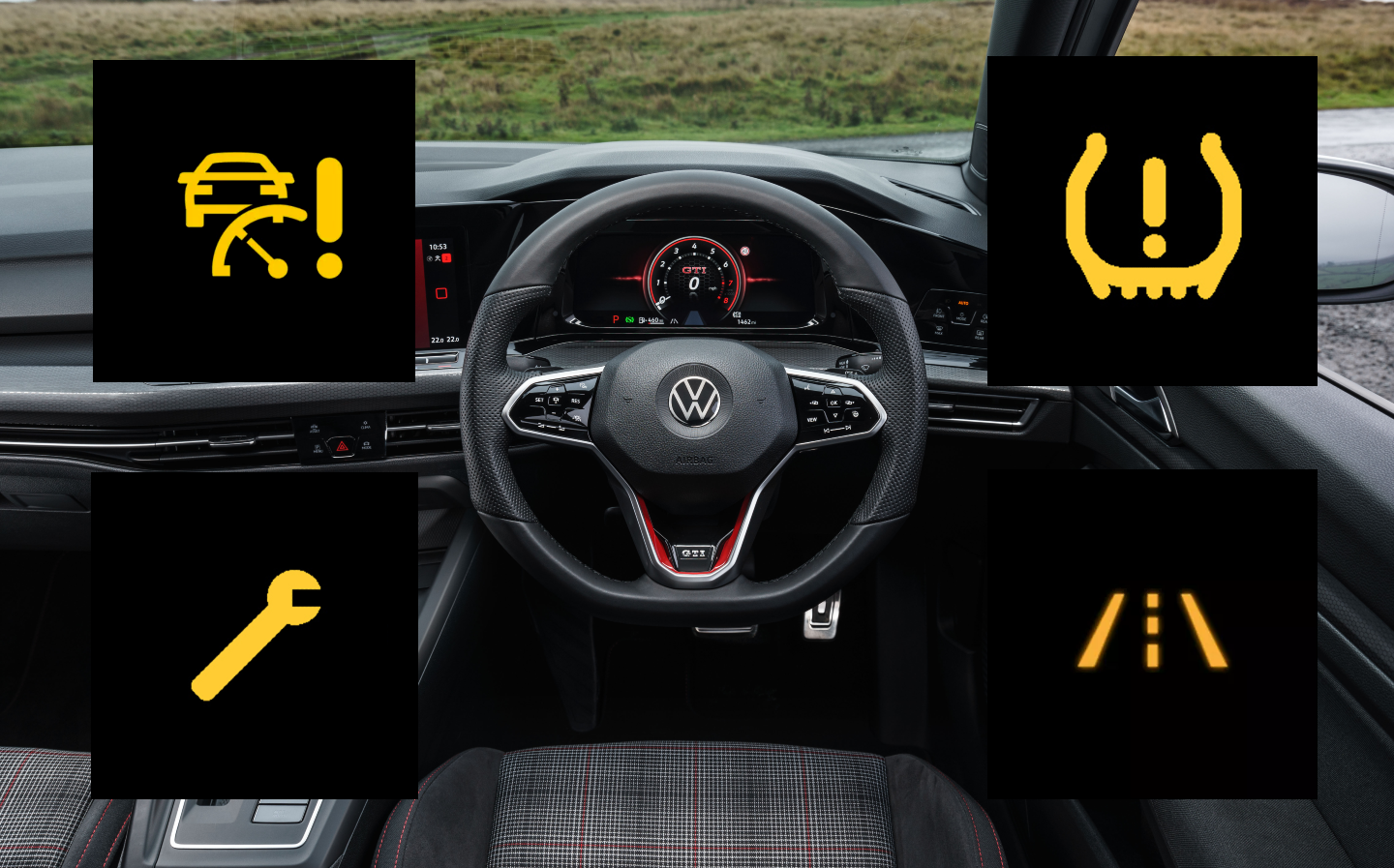Car dashboard warning lights and what they mean
Shining a light on some of the most important warnings
There’s a phrase that is particularly apt for this time of year, and it’s “my car’s dashboard lit up like a Christmas tree”. But while it might sound festive and jolly, it’s actually describing a rather alarming situation for a driver.
With lots of technology fitted to cars, it means there is an increasing number of warning lights in the dashboard to tell the driver if any of these systems fail.
So, if you have a dashboard lit up like a Christmas tree, it means a number of these items of equipment on your car have failed — with potentially dangerous consequences.
We’ve gone through and identified some of the key dashboard warning lights, so that you’re aware exactly what they mean and what to do if you see one.
Oh, and always remember the colour-coding system. Unlit, white, green or blue mean the system is working well. Yellow lights usually mean there is a minor fault or a “trigger” warning, in the case of some safety equipment. And red lights mean a serious fault that needs immediate attention.
AdBlue warning light

Specific to diesel cars, AdBlue is a chemical fluid with a separate onboard storage tank and supply system. Its role is to reduce exhaust emissions, and once a diesel car is out of AdBlue its on-board computer will prevent it being driven. The idea is that it cannot be driven without the full emissions-reduction functionality.
Usually, vehicles with AdBlue systems give you 1,000 miles’ notice that they’re going to run out, so you will see this light in the dashboard for a long time before it runs out.
Autonomous emergency braking (AEB) triggered/ fault

AEB goes under a variety of names from manufacturer to manufacturer, but essentially it is the automatic braking function your car can provide if it believes it is about to hit something ahead, whether it be another car, bollard, pedestrian, cyclist or something else.
If it’s not working, it will illuminate yellow and flash up a worded warning. It can also illuminate when the system has just been triggered, perhaps in red with a high-pitched, rapid beeping noise. If it’s deactivated or unavailable you may see this symbol with the word “OFF” next to it.
Airbag warning light

Airbags have been standard safety gear on all cars since the late 1990s and they’re a crucial piece of equipment to protect passengers. Therefore, if you see this yellow illuminated symbol, it means the airbag system — and/ or the seatbelt pre-tensioner — isn’t working correctly and should be checked out by an expert as soon as possible.
Battery warning light

In petrol or diesel cars, this will relate to its 12-volt battery that powers the electrical systems. It comes on at the ignition stage every time you start the car, but it should extinguish almost immediately once the engine is running. If it doesn’t, you’ve got low charge or a near-defunct battery, or the charging circuit that uses the alternator to charge the battery may have an issue.
In electric vehicles (EVs), it’s pretty much the same story – so don’t be confused into thinking this symbol is relating to the traction battery; we’ll come onto that later. Instead, the battery light in an EV still relates to the 12-volt system that powers the cars ancillary systems. If it does illuminate, you need to get the car checked by a garage ASAP.
Brake warning lights

A circle framed by two brackets relates to your brakes.
A symbol in the centre might be an exclamation mark (general brake warning), a bulb with a cross through it (brake lights), empty with dotted brackets (brake pads). The letters “ABS” (anti-lock brakes) or even “RBS” (regenerative braking system, pertaining to EVs and hybrids specifically) might show.
Whichever it is, a problem with your brakes is clearly very serious indeed and should be looked at by a qualified technician asap.
Engine coolant warning light

An internal combustion engine requires coolant to prevent overheating, and this is the light that appears if the coolant level is low or its temperature too high.
Don’t ignore it — it may just be as simple as you needing to top up with the right mix of water and antifreeze. But you do not want the engine to overheat in any circumstances, as the bill for fixing it will be enormous.
DPF warning light

A diesel particulate filter (DPF) helps remove the most harmful of diesel exhaust emissions. DPFs can be problematic if diesel car drivers only do low-mileage, short-distance journeys, as they clean themselves with exhaust heat via a process called “cycling”. If you regularly drive in town, your exhaust might not get hot enough to trigger cycling and the DPF could eventually ‘clog up’ or malfunction as a result, in which case you’ll see this light. You’ll need a garage’s intervention to then sort the problem out.
A straightforward way to prevent this is to drive the car for a prolonged distance and time on the motorway at higher speeds. Do this once a month and the DPF will cycle regularly, hopefully stopping the clogging issue from developing.
Door open warning light

A very simple one and the easiest to remedy. This little logo informs you that one of the doors — or perhaps even the bootlid, bonnet or sunroof, if these do not have separate warning lights — is not in the fully closed position.
You merely need to stop the car and close the related item properly; obviously, if it’s the bonnet or boot, you’ll have to get out of the vehicle to do so.
Driver attention warning

A relatively new one, as it is a piece of advanced driver assist safety (Adas) technology. Driver alert/ attention/ monitor systems keep an eye on the car’s steering inputs and throttle controls, and even — in models with in-car cameras — the driver’s eye movements, to assess if it thinks the driver is paying attention to the road.
If it believes they are not in full control, it will flash up some form of a coffee cup logo and a message inviting you to take a break from driving.
Some of these systems are also timed, so they will automatically activate after around three hours of continuous driving, even if you feel fully awake and fresh behind the wheel.
Engine warning light

One of the big ones and not to be ignored, although it can illuminate more often than you might think as a preventative measure. This is just to protect the car’s vital propulsion system from more significant long-term damage, or at times if there’s something affecting the emissions.
Anyway, the engine warning light or engine management light (EML) either illuminates yellow or red. Yellow could be something minor, like a sensor fault, but red is a dire warning of imminent failure. Either way, you’re best going straight to a garage to find out what the problem is.
Fuel/ battery level warning light

One of the oldest warning lights in existence, you should know what the fuel level warning light looks like by now. On petrol, diesel or hybrid cars, it’s a little old-fashioned fuel pump symbol, complete with the hose to one side of it. It means you’re low on whichever fuel your car uses.
It usually feature an arrow pointing to the side of the car on which the filler is located.
For EVs, it’s slightly different. It looks remarkably similar to the fuel pump but at the end of the cable part of the graphic is a two-pin plug motif — indicating that you need to plug in the car soon.
Glowplug coil warning light (diesels)

Another one specific to diesels. Avoiding getting too technical, glowplugs heat the diesel fuel entering cylinders when you first start the engine, to allow the combustion process.
When you switch the ignition on, this symbol will light up yellow, and you should NOT start the engine until it has extinguished. This used to take a while but in modern diesels it should only take a second or so. It may take longer in cold weather than it in warm.
If the symbol remains illuminated for a sustained period, perhaps even after the engine is running, then there’s a fault with the glowplugs and you’ll need a qualified technician to intervene.
Cold outside temperatures warning light

This one often illuminates in white, blue or yellow, but it can also light up red. However, in essence, what the little snowflake emblem is telling you is that the outside temperature is lower than either three or four degrees (depending on the manufacturer in question’s preferred thermal limit), and therefore there’s a high chance of frost, ice or black ice on the roads.
There will usually be a worded warning and an audible beep to accompany this signal illuminating.
Lane departure warning light

Like AEB, this technology goes under many names but it’s a newer piece of ADAS all the same and is almost universal in the car world these days. All it means when it illuminates, usually accompanied by an audible signal as well, is that the car thinks you are veering out of your assigned lane without using your indicators. If your vehicle has an evolved version of this tech called lane keep assist (or some variation thereof), then it will automatically and gently steer you back into the centre of your lane at the same time.
If you don’t like having the car drive for you, it is possible to deactivate both lane departure warning and lane keep assist in modern vehicles. However, when you do, you’ll find this logo is permanently illuminated yellow somewhere in your dashboard, until you switch the car off – whereupon it automatically defaults to being active again.
Oil level/ pressure warning light

Another one that EV drivers don’t have to worry about, this one is crucial to cars with internal combustion engines. It means the oil level (or pressure, depending on the car) in the engine’s lubricating supply system is low, so you need to top up with the correct grade of oil for your vehicle imminently.
Check your handbook for the correct grade of oil or look it up online if needs be.
Pedestrian noise alert fault

This one is only for EVs. A piece of European legislation dictates that any pure electric vehicle must emit an audible external noise at speeds of up to 19mph (30km/h) to alert pedestrians it is on the move. This is most often a low wail or humming sound, so that pedestrians know the car is coming towards them.
Therefore, if this speaker over the front of the car symbol lights up, it means that pedestrian warning noise outside the vehicle isn’t working at sub-19mph. And that means people on foot might not hear your EV coming towards them in urban areas.
Power steering fault warning light

Most would agree that being able to steer a car is a pretty important. Therefore, if you see this logo illuminate at all while driving you need to immediately reduce your speed and head for the nearest garage to see what is wrong with your steering system.
It is a problematic enough light to see on your dash if you have an older car, with hydraulic power-assisted steering (PAS), but the relatively straightforward remedy is often to top the system up with the correct grade of steering fluid. However, some newer cars have electric or “drive-by-wire” systems, without a direct mechanical link to the steering wheel, which makes the issue considerably more serious.
Radar/ adaptive cruise control fault warning light

Radar — or adaptive — cruise control uses sensors on the front of the vehicle to keep it a set distance from the vehicle in front.
If this warning light comes on it means the system isn’t working properly. Usually, this will deactivate the cruise function immediately if it’s enabled, but some cars will then default to a standard, passive system, which means the vehicle will just continue on at whatever speed you’ve chosen it to drive at.
If this warning light is on and you’ve not noticed, you run the risk of your vehicle driving straight into the back of the car in front. Another reason to always be alert while driving. Get the system checked out immediately.
Seatbelt warning light

Pressure sensors in the vehicle’s seat pads can determine when it is occupied, and if the person sitting there won’t put on their seatbelt, the car lights this symbol up red.
Most vehicles now will also tell you which seat in the cabin is the one with the unsecured passenger, too.
On most cars built in the 21st century, you’re unlikely to be able to ignore this light for long because if you drive even for a very brief period of time with a seatbelt undone, the car emits progressively more hysterical and insistent warning bongs until either the seatbelt is fastened, or the vehicle comes to a stop and is switched off.
Spanner symbol warning light

The spanner symbol is for all types of vehicles and usually lets you know that a service is due. Annual maintenance keeps everything in tip-top order, and a record of regular services can help resale values, so you should contact your favoured garage and book the car in.
In some brands of car there may be an additional reason for a spanner symbol, and it may be a pressing concern, so don’t wait — have it looked at asap.
Tortoise symbol

This one is most commonly used on EVs, but it can be seen on occasion in some petrol, diesel and hybrid cars.
It means the propulsion system is operating at reduced power, due to a fault.
On an EV, it could illuminate because the high voltage battery is very low on charge, and it will put the car in a “limp home” mode that hopefully will allow you to crawl to a charging point. But in all other cases if you see the tortoise, you’re best-off heading to a garage to find out what’s going on.
Tyre pressure warning light

A tyre pressure monitoring system on modern cars performs an important safety function, using sensors in the wheels to determine any of the tyres is losing pressure. It’s a brilliant safety feature in most circumstances.
Bear in mind, though, that TPMS can give false readings. When it illuminates, you should check tyre pressure immediately, though if you find they’re all correct you should reset the sensors via the car dashboard. You may have to do this after new tyres are fitted, too.
Related articles
- If you found our guide to dashboard warning lights interesting, you might like to know if electric cars are more likely to catch fire than petrol and diesel cars
- Britain to push back ban on new petrol and diesel cars to 2035, confirms Rishi Sunak
- UK needs ten times more electric car charging points by 2030
Latest articles
- Watch new Porsche 911 GT3 smash Nürburgring record for manual cars
- Skoda Elroq 2025 review: Czech carmaker can’t seem to miss with its electric family cars
- Five best electric cars to buy in 2025
- Should I buy a diesel car in 2025?
- F1 2025 calendar and race reports: The new Formula One season as it happens
- Zeekr 7X AWD 2025 review: A fast, spacious and high tech premium SUV — but someone call the chassis chief
- Denza Z9GT 2025 review: Flawed but sleek 1,062bhp shooting brake from BYD’s luxury arm
- Extended test: 2024 Renault Scenic E-Tech review
- Best-selling cars 2025: The UK’s ten most popular models of the year so far














